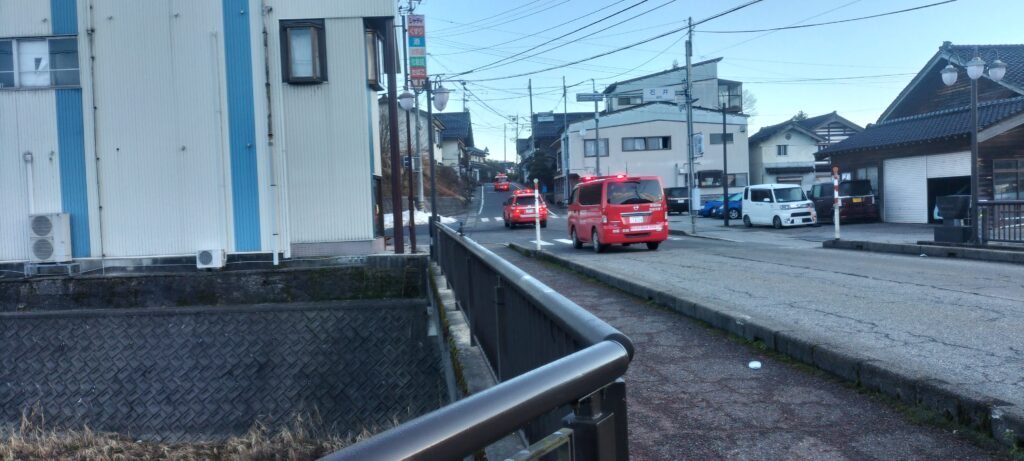
Earthquakes in Japan
Whether you studied science in school or learned about recent major earthquakes in Japan through news or social media, most people are aware that Japan is particularly prone to earthquakes due to its unique geographic location.
How often do Earthquakes occur in Japan?
How often do earthquakes occur here? According to the Japanese Meteorological Agency, small earthquakes with magnitudes of 1 to 3 happen somewhere in Japan almost daily.
Weather News, a popular app. used by many here including myself also tracks Earthquakes. Additionally, more significant earthquakes of at least magnitude 5 occur several times yearly. Earthquakes of a magnitude of 6 or higher usually happen once or twice every decade, sometimes more often.
To give you an idea of how often Earthquakes occur in Japan here is a screen shot of my Weather News App on my phone. This will show how many Earthquakes happened over the last seven days at the time I am writing this article.
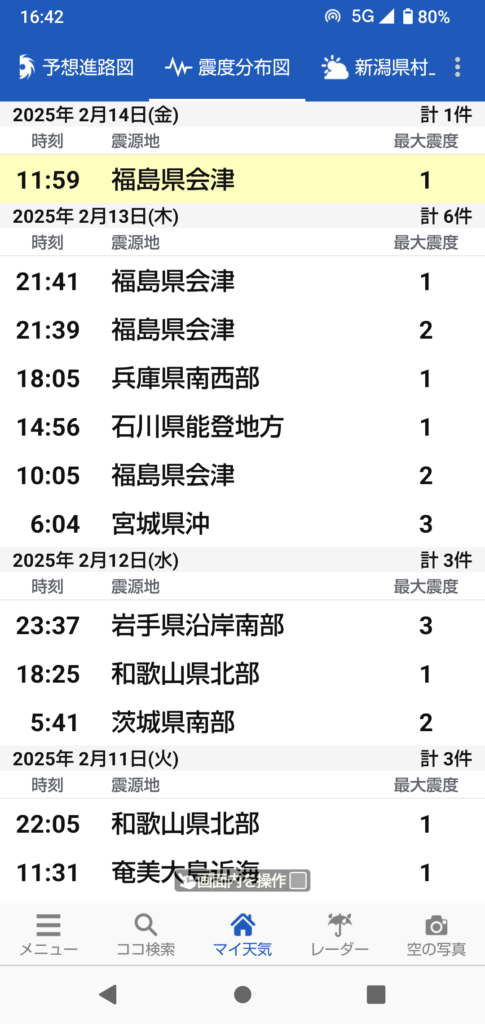
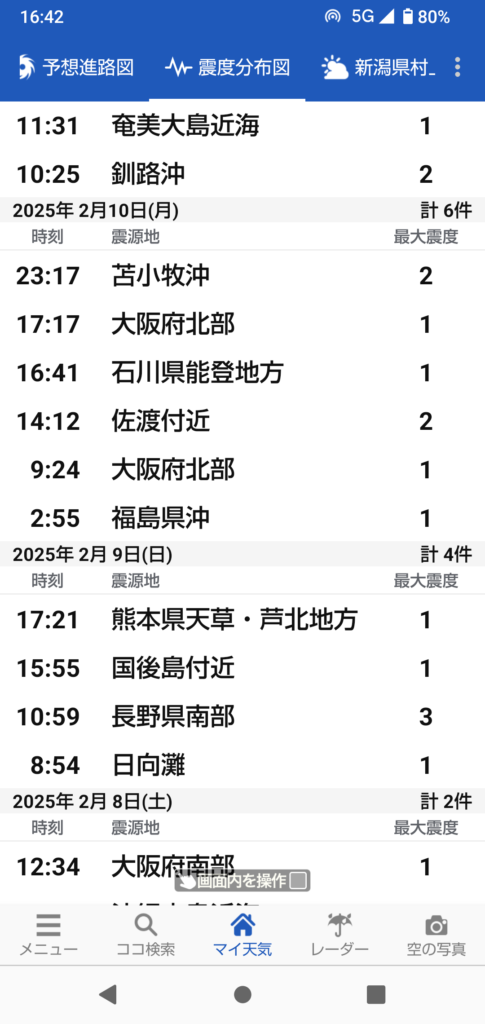
In the past six days, more than 25 earthquakes have been recorded in various locations across the country. Below you’ll find a translation of the Japanese text, providing a clear understanding of the information presented in the screenshot above.
Earthquake jishin じしん 地震 Location of Seismic Intensity しんどぶんぷず 震度分布図 Here is an example of how a date is written in Japanese 2020年2月12日 2025 year nen ねん 年 February 2 gatu がつ 2月 12 twelfth 12nichi 12日 こTime jikoku じこく 時刻 Epicenter しんげんち 震源地 Magnitude (Intensity of the Earthquake) さいだいしんど 最大震度
Based on the screenshots above, many of the earthquakes recorded had magnitudes of 1 or 2. It’s a common misconception that earthquakes of this magnitude are hardly felt. However, this is not entirely accurate. Whether or not you feel an earthquake largely depends on its depth and the ground under you. If an earthquake occurs at a very shallow depth, typically between 5 to 30 kilometers underground—like many do in Japan—you are likely to feel it, even if its magnitude is low.
Another important factor is the type of ground. Soft ground, which is often found in areas that were once wetlands and have since been developed, can significantly amplify the sensation of shaking. Many densely populated regions in Japan have soft ground, which means that earthquakes will be felt more strongly there, regardless of their intensity.
Japan’s Unique Location
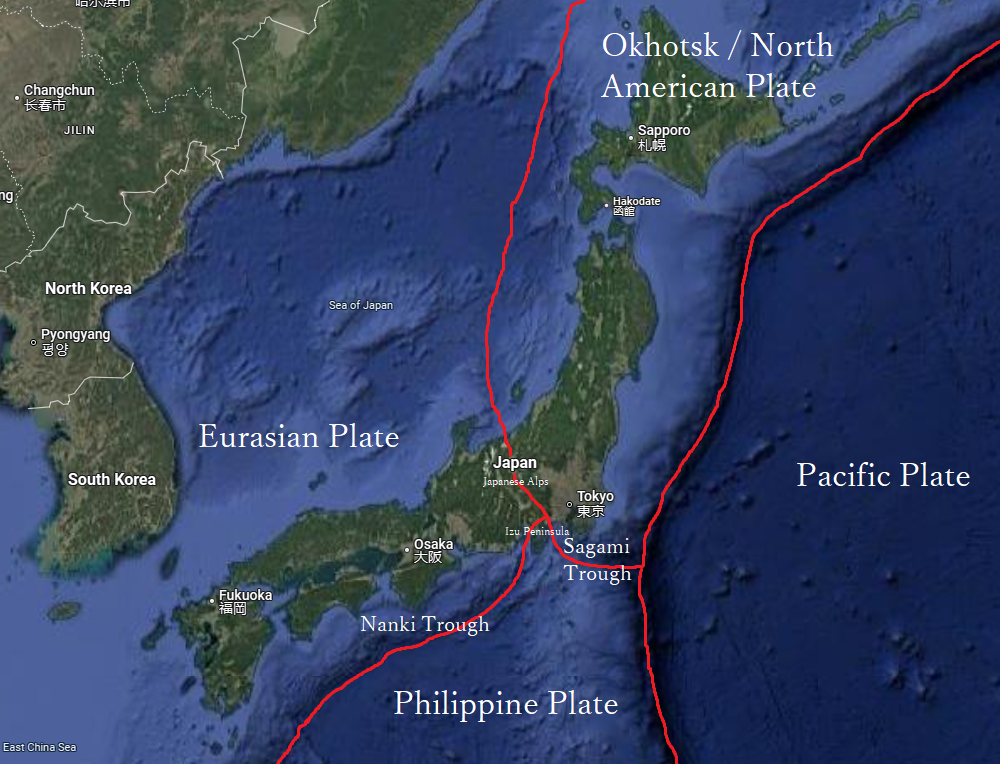
Japan is located in the Pacific Ring of Fire and is positioned at the intersection of four tectonic plates. The Okhotsk / North American Plate and the Eurasian Plate run through the country, dividing it with the Japanese Alps in the middle. To the south lies the Philippine Plate, which encompasses the Izu Peninsula and several small islands chains. This plate is also situated just off the southern Pacific coast of the islands of Honshu, Shikoku, and Kyushu. The Pacific Plate is located to the east of the country. As a result, Japan is highly susceptible to both small and large earthquakes.
Future Earthquakes in the Nanki and Sagami Troughs
The Japanese government has issued warnings about the possibility of future catastrophic earthquakes occurring along the Nanki Trough, which extends from the Izu Peninsula in Shizuoka to the waters off the island of Kyushu. Additionally, the Sagami Trough, located between the Izu Peninsula in Shizuoka and Chiba Prefecture in the Kanto region, is also of concern. Also known as Mega quakes, Catastrophic Earthquakes have a magnitude of 8 or greater. These warnings are for municipalities prepare for this type of an Earthquake. Along both of these troughs is where many of the main Japanese population centers are located including Tokyo, Chiba, Yokohama, Shizuoka, Nagoya, Yokkaichi, Tsu, Wakayama, Osaka, Tokushima, Kochi, Miyazaki, and many other smaller municipalities along these costal areas of Japan.
The Japanese government is primarily focused on the potential future earthquake in the Nanki Trough. However, this emphasis may distract attention from other areas that could experience catastrophic earthquakes sooner than the Nanki Trough event. Here are two examples of earthquakes that caught Japan off guard.
March 11th 2011
A prime example is the catastrophic 9.0 magnitude earthquake that occurred on March 11, 2011, off the coast of Miyagi Prefecture in the Tohoku Region. This earthquake triggered a massive tsunami and caused a nuclear accident at the Fukushima Daiichi Nuclear Power Plant, resulting in the loss of over 10,000 lives.
January 1st 2024 Noto Peninsula Earthquake
Another example is the 7.6 magnitude earthquake that struck off the Noto Peninsula on January 1, 2024, which my family and I experienced firsthand. This earthquake began as a swarm that had been affecting the Noto Peninsula since December 2020. Prior to the earthquake, the media downplayed the significance of the swarm, attributing it to trapped water underground and suggesting that there was nothing to worry about. They were puzzled by the swarm because, at the time, there were hardly any known faults beneath the Noto Peninsula. It wasn’t until after the 7.6 earthquake occurred that information was released to the public indicating that a very large earthquake could happen in the area.
Other areas of Japan that could face Large Earthquake
The Sagami Trough area is located east of Izu, stretching from Shizuoka to Chiba Prefecture and encompassing the Southern Kanto Region as a whole. Chiba and Ibaraki prefectures often experience frequent earthquakes. If a significant earthquake were to occur in this region, it could impact one of the most densely populated areas in Japan.
The Hokkaido Sanriku area is located in northern Japan, near Iwate and Aomori Prefectures, and just off the coast of eastern Hokkaido. This region is seismologically active, and there is a possibility of a large earthquake occurring here in the near future, potentially before the Nanki earthquake.
Niigata, Toyama, and Ishikawa Prefectures. In June of 2024, the Earthquake Swarm that had affected the Noto Peninsula since December 2020 and caused the 7.6 January 1st Earthquakes of 2024 had tapered off. Two regions, one on the West coast of Ishikawa Prefecture near Shika Mura, Hakui, and Kanazawa. Another between the west coast of Noto Peninsula and Sado Ga Shima has continued to be seismically active.
There are two areas that could potentially trigger larger earthquakes in the near future in this region. An earthquake off Sado Island could impact cities such as Kashiwazaki, Joetsu, Itoigawa, Sado Island, Niigata City, and many other locations in Niigata Prefecture. Additionally, cities along Toyama Bay, including Toyama City, Uozu, Takaoka, and Himi, may also be affected. In Ishikawa Prefecture, the earthquake could impact Nanao City and the Okunoto Area once more. Furthermore, another earthquake off the west coast of Ishikawa could affect the Noto Region, as well as Kanazawa, Kaga, and Fukui Prefecture.
Kyushu Island as a whole. Especially the southern parts of Miyazaki Prefecture and Kagoshima prefecture have been seismically active. Off the coast between Oita Prefecture and the Island of Shikoku is another area of concern.
Other areas to watch out for are Aichi Prefecture and the Tokai Region. The Kansai, Region, especially Wakayama which has been very sesimically active recently, Osaka and Kyoto.
No matter where you live or travel in Japan, there is always the potential for earthquakes.
Acknowledging the possibility of Earthquakes is very important
While most travelers to Japan may not prioritize earthquakes in their planning, it’s essential to consider them as part of your travel preparation. By acknowledging the possibility of earthquakes, whether you’re visiting for a few days or planning to stay for an extended period, you can take proactive steps to ensure your safety and peace of mind during your trip.
Tourism and Potential for Disaster in Japan
Since 2023, when Japan reopened to tourists after the pandemic, the country has experienced record numbers of foreign visitors. This trend is unlikely to slow down in the near future. However, the likelihood of large or catastrophic earthquakes is also on the rise. Therefore, the Japanese government should take proactive measures to raise awareness among foreign tourists about the potential for earthquakes during their visit.
Contingency plans need to be in place, and the government should provide information in multiple foreign languages, including English, German, Spanish, Chinese, Korean, Vietnamese, and other languages spoken by tourists.
As of 2025, very little information is available to assist foreign nationals in the event of a disaster. The Japanese government is grossly unprepared for this. This situation needs to change. Drawing from my firsthand experience with earthquakes, I aim to provide as much relevant information as possible to raise awareness about the potential for disasters during your stay. While it’s likely that your visit will be enjoyable and uneventful, Japan’s unique location and constant geological activity make it essential to be prepared rather than unprepared.
Experiencing an Earthquake that is a 6 or above is the only way to understand it
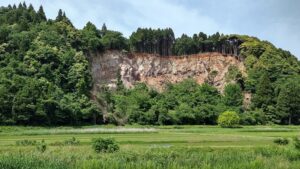
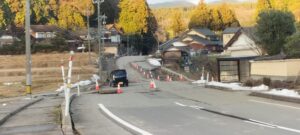
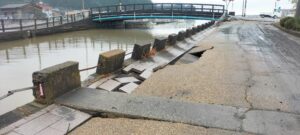
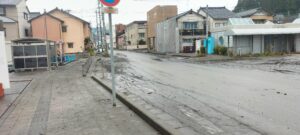
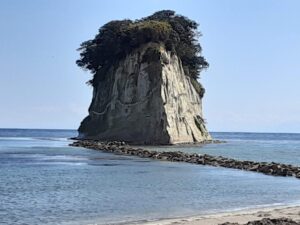
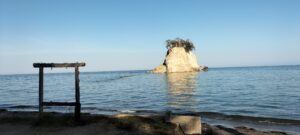
I took these pictures after the earthquake and during the spring of 2024. I want them to illustrate the sheer power of what earthquakes can do in just a matter of seconds. I also learned from experience about Tsunami it may not occur in one location, but just a few hundred meters away, total devastation can be caused by it. Ushitsu was fortunate because of its location; it only experienced a small tsunami that left behind mud in its wake. This is in stark contrast to the destruction caused by the four-meter tsunami that devastated Shiromaru, Ida, and many other places in Suzu and throughout the Noto Peninsula.
There truly is no way to fully prepare for such an experience. No matter how much you prepare, how many precautions you take, how many earthquake or disaster drills you participate in, or how many experts advise you on what to do during an earthquake unless you have personally gone through it even if you have experienced it, you cannot be prepared for what is to come.
What can go wrong will definitely go wrong, and what you never thought could happen will absolutely occur. During an earthquake and its aftermath, no one is fully ready. That’s why the best approach is to prepare as thoroughly as possible and to be aware of the necessary actions to take afterward.
Earthquake Survival Blog
Whether you’re living in or traveling to Japan, my Earthquake survival blog is here to share my family’s experiences during the 7.6 magnitude earthquake that struck the Noto Peninsula on January 1, 2024. My mission is to equip you with essential information that can help you in an earthquake and navigate its aftermath. I will highlight the challenges my family and I have overcome, as well as the ongoing efforts we are making to rebuild our lives. My aim is to prepare foreign residents, expats, and tourists in Japan to effectively handle both an earthquake and its consequences.